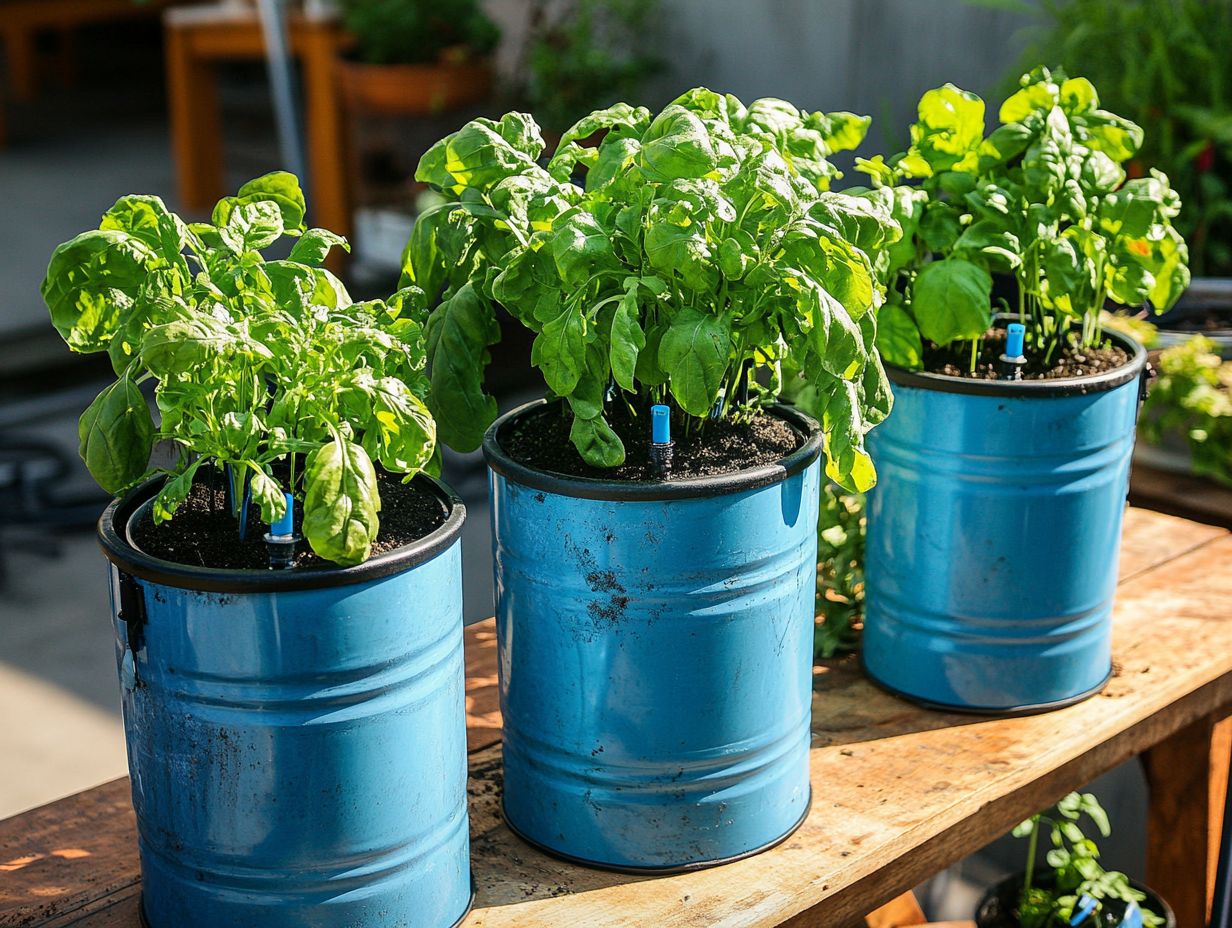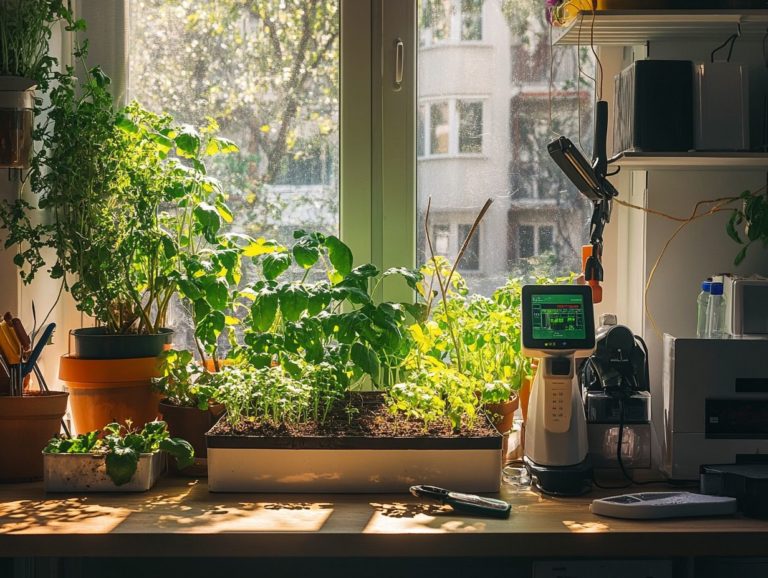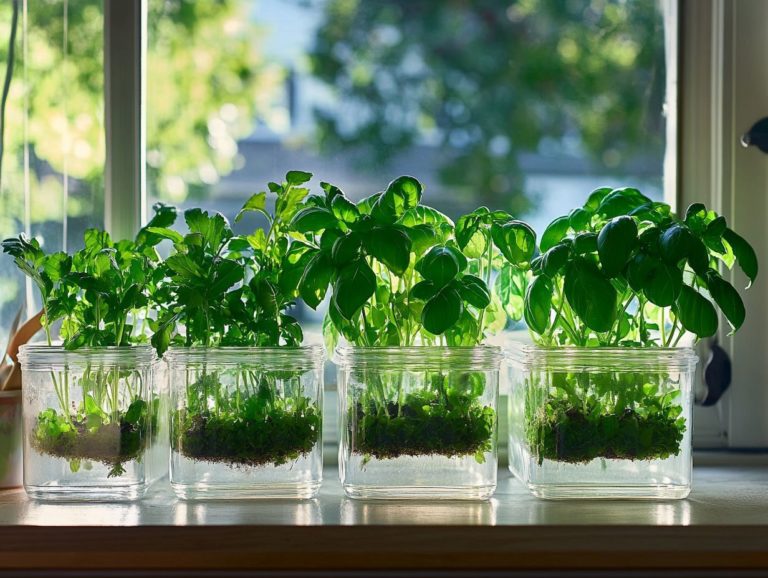How to Make a Hydroponic System with Barrels
Hydroponics is revolutionizing the way food is grown. This innovative method enables soil-free cultivation that optimizes space and resources to their fullest potential.
If you re eager to dive into this gardening method, utilizing barrels can be a transformative choice. They are budget-friendly and versatile, streamlining the hydroponic process for you.
This guide will show you why barrel systems are a game changer for your garden! You ll discover the advantages of barrel systems, essential materials, and a comprehensive step-by-step assembly. Get ready to explore exciting insights that will kickstart your hydroponic journey!
Contents
- Key Takeaways:
- What is Hydroponics and How Does it Work?
- Benefits of Using Barrels for Hydroponic Systems
- Materials and Tools Needed
- Essential Components for Building a Barrel Hydroponic System
- Step-by-Step Guide to Building a Barrel Hydroponic System
- Preparation and Assembly Process
- Tips for Maintaining and Troubleshooting Your System
- Creative Ways to Use Your Barrel Hydroponic System
- Frequently Asked Questions
- What materials do I need to make a hydroponic system with barrels?
- Can I use any type of barrel for my hydroponic system, such as a 55-gallon barrel?
- How do I prepare the barrels for my hydroponic system?
- What type of plants can I grow in a hydroponics system with barrels, including aquatic plants?
- Do I need any special skills or knowledge to make a hydroponic system with barrels?
- How often do I need to change the nutrient solution in my hydroponics system, including water management practices?
Key Takeaways:

- Hydroponic systems with barrels are a cost-effective and versatile solution for growing plants without soil.
- Essential components for building a barrel hydroponic system include barrels, a water pump, and grow media.
- Maintain optimal plant growth by regularly checking and adjusting water levels, pH levels, and nutrient levels in your system.
What is Hydroponics and How Does it Work?
Hydroponics presents a groundbreaking approach to cultivating plants without soil. It employs a system where fish and plants grow together, ensuring efficient nutrient delivery directly to the roots while preserving optimal water quality.
This eco-friendly method supports urban gardening and champions sustainable agriculture. By using a closed-loop system, where aquatic plants and fish thrive together, you foster plant growth through a harmonious balance of natural resources and effective waste management.
Benefits of Using Barrels for Hydroponic Systems
Utilizing barrels for hydroponic systems offers numerous advantages, particularly their compact design. This feature maximizes space efficiency, making barrels ideal for urban gardening, where fresh produce can flourish even in limited areas.
This cost-effective method of DIY aquaponics allows you to engage in sustainable agriculture while creatively repurposing upcycled materials.
Cost-Effective and Versatile Solution
Barrel aquaponics is a cost-effective and versatile solution for navigating small-space gardening. It enables you to cultivate a diverse array of plants and fish in an environmentally friendly way.
This innovative system merges aquaculture and hydroponics, providing a fantastic option for aspiring gardeners who might feel intimidated by traditional methods. If you’re interested in creating your own setup, check out how to make a simple hydroponic system with jars. Its compact design allows barrel aquaponics to fit seamlessly into backyards, balconies, or community gardens, opening up opportunities for anyone ready to embrace sustainable practices.
You can thrive by choosing from a variety of fish, such as tilapia or goldfish, and pairing them with herbs, vegetables, or leafy greens. This nurtures a vibrant ecosystem. By utilizing fish waste to nourish the plants, this setup effectively recycles resources, resulting in low overhead costs and minimal environmental impact.
Materials and Tools Needed

Constructing a barrel aquaponics system requires various materials and tools. You ll need barrels to serve as your grow bed, PVC piping for an efficient plumbing system, and a high-quality water pump to ensure optimal water circulation throughout the setup.
Essential Components for Building a Barrel Hydroponic System
Essential components for crafting your barrel hydroponic system include a fish tank for aquatic life, a grow bed for your plants, and a dependable water supply system to keep nutrient levels and water quality in check.
The fish tank serves a crucial role in this ecosystem by providing a habitat for fish, whose waste is rich in nutrients that are vital for plant growth. As water flows from the fish tank to the grow bed, beneficial bacteria work their magic, converting ammonia from fish waste into nitrates that your plants eagerly absorb. This symbiotic relationship not only boosts the growth of various crops but also helps maintain water quality, ensuring your aquatic life thrives.
By harnessing this natural filtration system, you can create a balanced environment. In this environment, both fish and plants flourish together in perfect harmony.
Step-by-Step Guide to Building a Barrel Hydroponic System
Building a barrel hydroponic system requires careful planning and a structured assembly process. You ll want to focus on careful preparation to ensure effective water management, setting up your garden for success.
Each step you take will lay the foundation for a thriving ecosystem, allowing you to reap the rewards of your efforts.
Preparation and Assembly Process
The preparation and assembly process for barrel aquaponics demands meticulous planning on your part. You’ll need to set up the plumbing system thoughtfully to ensure proper water circulation.
A well-designed plumbing system is essential; it optimizes water flow between the fish tank and the grow beds while preventing stagnation, which can invite algae growth or hinder nutrient distribution. As you assemble the components, make sure the pipes are securely fitted and free from leaks because even the smallest drip can waste valuable resources over time.
Regular maintenance checks, like cleaning filters and inspecting joints, help keep your ecosystem healthy.
By adopting these proactive strategies, you’ll foster an efficient environment where both plants and fish can thrive together, maximizing yield and paving the way for long-term success.
Tips for Maintaining and Troubleshooting Your System

Maintaining and troubleshooting your barrel aquaponics system is essential for achieving optimal growth and effectively addressing any common issues that may arise, especially those related to water quality and fish care.
Focus on these aspects to keep your system thriving!
Ensuring Optimal Growth and Addressing Common Issues
To achieve optimal growth in your barrel aquaponics system, it’s crucial to tackle common challenges like water management, as this directly affects plant roots and the overall health of the system.
Effective water management starts with regularly monitoring pH levels and ensuring the water remains clean and free from contaminants. Implementing a filtration system can greatly enhance both water clarity and quality, making a noticeable difference in your setup.
Another essential element is maintaining the right water temperatures, which play a significant role in nutrient absorption and the vitality of your fish. To take your system to the next level, consider employing waste management practices such as composting fish waste; this creates a nutrient-rich environment that benefits your plants.
By balancing these factors, you foster the natural symbiosis between fish and plants, paving the way for a flourishing aquaponics system. This method is a great way to practice environmental conservation.
Creative Ways to Use Your Barrel Hydroponic System
Exploring creative avenues for your barrel hydroponic system can unlock innovative design concepts and enable the cultivation of unique crops. This approach not only fosters self-sufficient gardening but also captivates those just starting their hydroponics journey.
Dive into the world of hydroponics today and discover the joy of growing your unique crops!
Alternative Crops and Design Ideas
In a barrel hydroponic system, you can cultivate alternative crops like lettuce, spinach, and various herbs.
Innovative design ideas can take your space efficiency to the next level, supporting continuous harvest.
Consider incorporating vegetables such as radishes and dwarf tomato varieties, which thrive beautifully in these systems. To truly maximize your urban gardening potential, think about using vertical structures like wall-mounted barrels or tiered planting setups. These strategies can dramatically increase your yield, even in tight spaces.
Plus, integrating a drip irrigation system ensures that each plant receives the optimal nutrients they need to flourish. You might explore using compost teas as a nutrient supplement. This not only promotes environmental sustainability but also guarantees a robust crop yield.
With these approaches, you’ll optimize your space and create a more self-sufficient growing environment, making hydroponics an invaluable choice for urban living.
Frequently Asked Questions

What materials do I need to make a hydroponic system with barrels?
To make a hydroponic system with barrels, you will need the following materials:
- 2 barrels (preferably food-grade)
- Grow media (such as clay pellets or coco coir)
- PVC pipes and fittings
- Water pump and pipes
- Net pots
- Plant food
- Plant seedlings or seeds
- Tools (drill, saw, etc.) for cutting and assembling the system
Can I use any type of barrel for my hydroponic system, such as a 55-gallon barrel?
It is recommended to use food-grade barrels for your hydroponics system. These are typically made of high-density polyethylene (HDPE) and are safe for growing plants. For a more sustainable agriculture approach, consider using upcycled materials. Avoid using barrels that contained chemicals or other harmful substances.
How do I prepare the barrels for my hydroponic system?
First, clean the barrels thoroughly with soap and water. Rinse them out thoroughly to remove any residue. Next, cut the barrels in half lengthwise using a saw. This will create two deep, trough-like containers to hold your plants.
What type of plants can I grow in a hydroponics system with barrels, including aquatic plants?
Imagine growing a variety of plants like leafy greens, herbs, strawberries, and even small fruit trees right at home! However, avoid growing large or heavy plants that may be difficult to support in the system.
Do I need any special skills or knowledge to make a hydroponic system with barrels?
No, you do not need any special skills or knowledge to make a hydroponic system with barrels. However, it is important to research and understand the basics of hydroponic gardening, such as proper nutrient ratios and water pH levels, to ensure your plants thrive in the system. For beginners, YouTube can be a great resource for educational gardening.
How often do I need to change the nutrient solution in my hydroponics system, including water management practices?
The frequency of nutrient solution changes will depend on several factors, such as the type of plants you are growing, the size of your system, and the temperature and humidity of the environment. Generally, it is recommended to change the solution every 2-3 weeks to ensure optimal plant growth and health. This is also a good time to check your water quality and nutrient levels.






